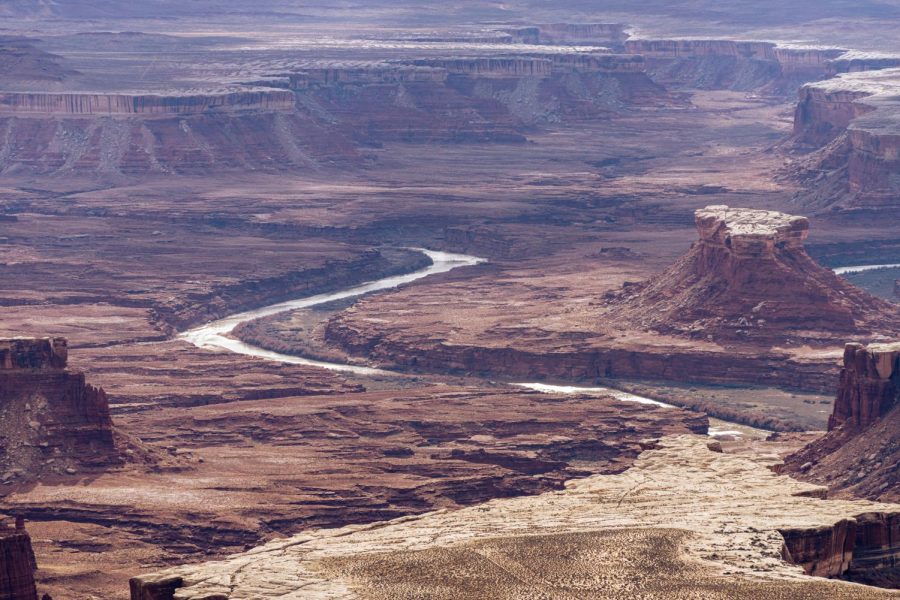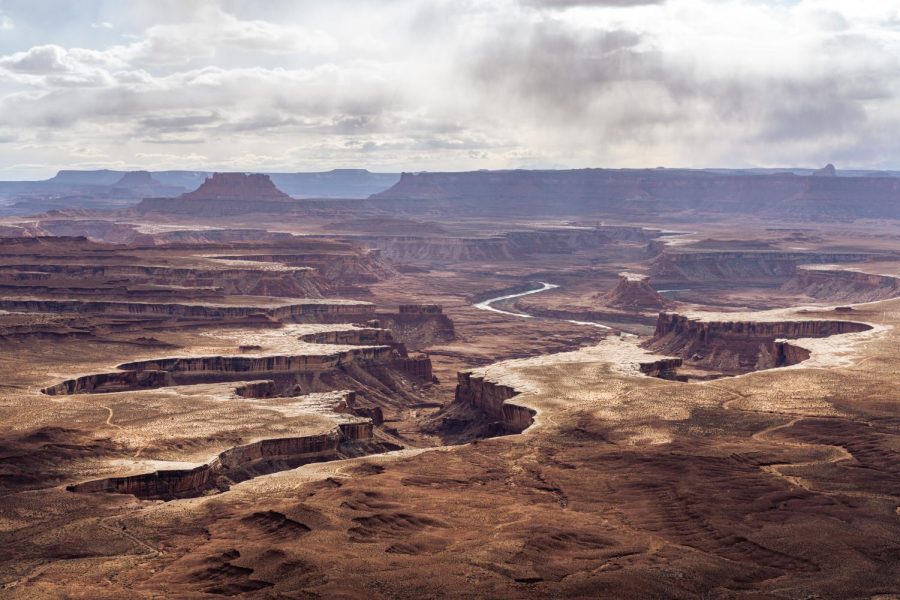How Does Utah Use the Colorado River?
Colorado River in Canyonlands National Park in Utah on March 10, 2022. (Photo by Xiangyao “Axe” Tang | The Daily Utah Chronicle)
February 6, 2023
As Utah continues to expand and lakes and rivers dry, it is important to consider one of the West’s major water sources — the Colorado River.
The Colorado River only accounts for 27% of Utah’s water usage, according to KUER, while the majority of Utah’s water comes from the rivers that feed into the Great Salt Lake. Utah is allowed to use 23% of the Colorado River. The other three states in the Upper Colorado Basin, Colorado, New Mexico and Wyoming, use 51.75%, 11.25% and 14% respectively, according to the U.S. Bureau of Reclamation.
Two-thirds of the Colorado River water in Utah is used for agriculture, mostly to irrigate alfalfa fields, KUER reports. An additional 15% of water is pumped to supply the Wasatch Front.
According to the Utah Division of Water Resources, 60% of Utahns benefit from the river. Utah uses around one million acre-feet of water annually.
Kevin Perry, a professor of geology at the University of Utah, said Southern Utah’s population is rapidly growing.
“They use a lot of water compared to the people in Northern Utah,” he said.
There is a plan to build the Lake Powell Pipeline, which would take water from one of the Colorado River’s tributaries, Green River, and pump it through Lake Powell to Southern Utah underground.
“The problem is, Lake Powell is drying up, and even if they spent the billions of dollars to build the pipeline, there may not be water to pump,” Perry said.
Perry also said the Colorado River’s water levels are decreasing at a rate of 10% to 15% each decade due to climate change. This has left several states, including Utah, unable to pull their allotted amount of water from the river, “because the water doesn’t exist.”
The Colorado River Compact
The Colorado River Compact was created in 1922 and divided the use of the river’s water into an Upper Basin and Lower Basin. Utah is an Upper Basin state. Perry said there is significantly less water in the river than there was 100 years ago, which creates problems for how states can use their allocation.
“The Colorado River Compact — it’s got lots of issues because it was created during a time period when there was lots of water,” he said.
Perry said farmers in Arizona lost access to water because their water rights weren’t as old as the other states.
“There’s really just not enough water to go around for the existing water rights,” he said.
According to The Salt Lake Tribune, Utahns use the most domestic water per capita in the Southwest and rank second nationwide.
Seven U.S. states are part of the compact: Arizona, California, Colorado, Nevada, New Mexico, Utah and Wyoming. But while tribal nations and Mexico also use the Colorado River, they are not part of the compact.
According to an article by KUER, while the Colorado River borders Hualapai land in the Northwestern part of Arizona, they are not able to pull water from the river.
The Ute Indian Tribe, located in Eastern Utah, has several rivers flowing throughout their land, and while they have access to some water rights, a settlement on how much more water they can use has never been reached.

Managing Water Usage
Lawmakers in Utah are focused on conservation efforts because renegotiating state water rights is hardly an option — the water does not exist for new negotiations.
In an interview with The Washington Post, Gov. Spencer Cox said Lower Basin states such as Arizona, California and Nevada are overusing their water.
“Many of the Upper Basin states, including Utah, we’re under our allocation,” he said, but that doesn’t matter when other states exceed their limit.
In the interview, Cox said to maintain Utah’s water supply, sacrifices will have to happen and mentioned several conservation bills passed in 2021, including a $40 million preservation trust for the Great Salt Lake.
According to Jennifer Shah, an associate professor of Environmental and Sustainability Studies at the U, new legislation requiring the metering of secondary water usage could lead people to review how they use their water and curb water usage in the state.
“That hasn’t been metered in the past and recent studies have shown that if you simply show people how much water they’re using, many reduce the amount — in some cases by a significant fraction,” she said.
Shah said another piece of legislation passed last year requires Utah cities to couple their land use and water use planning so when cities are developing, they need to take water use into consideration and coordinate with the entities that deliver water to them.
“As cities try to attract businesses, for example, or maintain or augment their economic base, they need to take into consideration how that might affect water use,” she said.
This article was updated on Feb. 7, 2023, to clarify that the majority of Utah’s water comes from the rivers that feed into the Great Salt Lake, not the lake itself.









